Our seed feeder fell a few days ago due to a faulty temporary hook, and it suffered an unfortunate crack in the tube. I have to give out kudos to Wild Birds Unlimited‘s lifetime guarantee. Eddie at the north Austin store repaired my feeder on the spot for no cost, and the only trouble I had was trying to get myself to leave the store without wanting to buy every feeder they had in the store.
I came home determined to go back to the original hook we’d used for years, and I intended to improve the cattle-panel cage we’d created to keep the doves out. Smaller, removable — and it now fits nicely under the protection of the dome. FYI, WBU sells a very nice cage that works with their feeders — I just had excess cattle panel available at no extra cost to me.
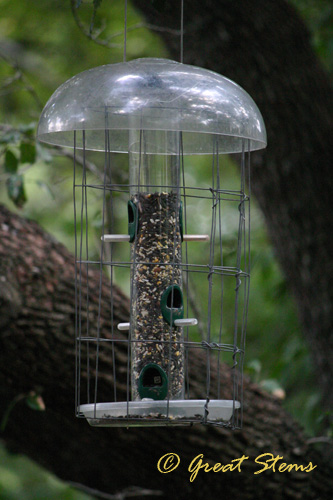 And sure enough, the doves have officially been fully thwarted. The new and improved cage keeps the doves out — and the squirrels in, haha (one squirrel panicked when my family was heading out to the car and it couldn’t figure out how to go back through the cage openings the way it came in — I had to rescue it by lifting up the dome with a broomstick).
And sure enough, the doves have officially been fully thwarted. The new and improved cage keeps the doves out — and the squirrels in, haha (one squirrel panicked when my family was heading out to the car and it couldn’t figure out how to go back through the cage openings the way it came in — I had to rescue it by lifting up the dome with a broomstick).
With the smaller cage, we’ve seen an expected slight reduction in the sheer numbers of little songbirds that hang out on the cage at a time, but they don’t have any problem getting seeds. Cardinals and their companions just go right in, and blue jays can now hang from the outside of the cage and grab peanuts from any of the holes they want. They also can fit in the feeder, but it’s a tighter fit than before. The only ones unable to use the feeder are the doves.
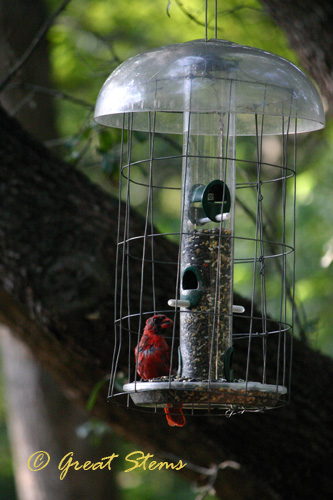
I’m just happy because the cage is nice and compact now, and there are no longer excess wires about. And it’s back on its nice sturdy hook. Though I didn’t take a picture of it, I used 16-gauge wire to create a pseudo cage on the top of the cattle-panel cage, so that the cage can rest on top of the tube and still be easily removable when I’m filling the feeder.
The finches now enjoy their thistle feeder in front of our kitchen window — it hangs from a shepherd’s hook, along with a hummingbird feeder (so now we get to enjoy hummingbirds from the kitchen, too).
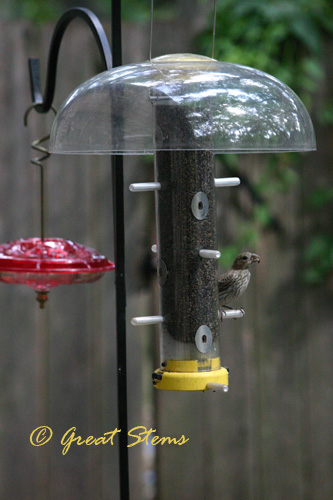
FYI, I took down the pretty hummingbird feeder my aunt gave me (she knows). See the rust on the top of the feeder? That same rust formed on the inside of the feeder, and that is very dangerous for hummingbirds. Iron contamination kills hummingbirds, and it doesn’t take much. As soon as I saw rust, that feeder came down.
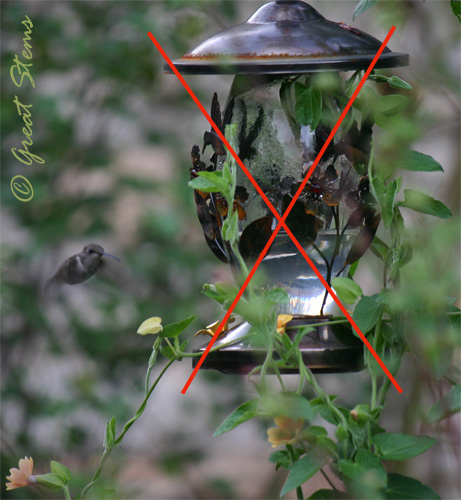 This is a case where it’s ok to buy plastic (glass feeders are more expensive and they can break, but they are an option, too). Pick a feeder that has zero metal, including copper, and make sure that it is easy to fully clean inside and out. Stick to white cane sugar to make your nectar — for the same reason as above — other sugars can contain iron and hurt the hummingbirds.
This is a case where it’s ok to buy plastic (glass feeders are more expensive and they can break, but they are an option, too). Pick a feeder that has zero metal, including copper, and make sure that it is easy to fully clean inside and out. Stick to white cane sugar to make your nectar — for the same reason as above — other sugars can contain iron and hurt the hummingbirds.
With the sun being so hot these days, I’m glad I have so many water sources available to the wildlife, and I’ve seen birds visiting every single one of them lately. I try to be really good about replacing the water every couple of days. Not only is that important for the birds’ health, but you want to prevent mosquito larvae.
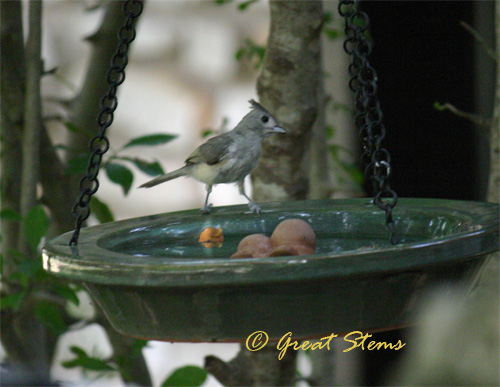 I’m very happy with all the changes. And the doves are back to foraging on the ground.
I’m very happy with all the changes. And the doves are back to foraging on the ground.
According to Eddie at Wild Birds Unlimited, doves need seeds without the shells, so when they consume the traditional sunflower seeds, they don’t get the nutrients they need, and that’s why they always seem hungry — they eat and eat and eat and come back for more. They do like millet, but millet is not a recommended seed for home feeders. Not only does it attract the pest birds that never leave — doves, house sparrows, and blackbirds — but because it’s wasted by other birds, it can harbor bacteria when it sits around too long. If you must use millet, only sprinkle it on the ground, and make sure to only use enough that can be consumed in a day. I don’t buy millet at all — the doves will have to make do with the peanuts and corn. The cage has really helped — we are down to a very manageable number of doves.
Chirp!
Those are good tips to know about hummingbird feeders. I bought a bird bath this spring and I have seen one bird. I have moved it a couple of times. I need to do a little searching to find out why. I love your last photo! That is a pretty little bird.
It took a while before I saw the birds visiting our birdbaths regularly. They do favor the ones closest to the birdfeeders, I’ve found.
I only discovered your blog minutes ago but I am fascinated and have already bookmarked it.
I have an idea for building a small “aviary feeder” to deter larger birds. Can you tell me the dimensions of the openings of the “cattle panels” you used? Any other tips would be greatly appreciated as well. I am thinking of putting several different types of feeding stations inside the “aviary”, safflower, thistle, sunflower, etc. and creating other embellishments to attract desirable birds.
Steve, our cattle panel openings are about 2×4″ — the wire’s gauge is flexible enough to allow us to bend and shape it, making it very handy. We also used it for our vegetable trellises and to create protectors around some of our young trees. I like the idea of creating stations and seeing which seeds most attract particular species of wildlife!
I forgot to mention that I am in Phoenix, AZ and we do not have any problems with squirrels, mainly just mourning doves and pigeons.
Those pesky doves and pigeons! The cattle panel will definitely do the trick to deter those larger birds.